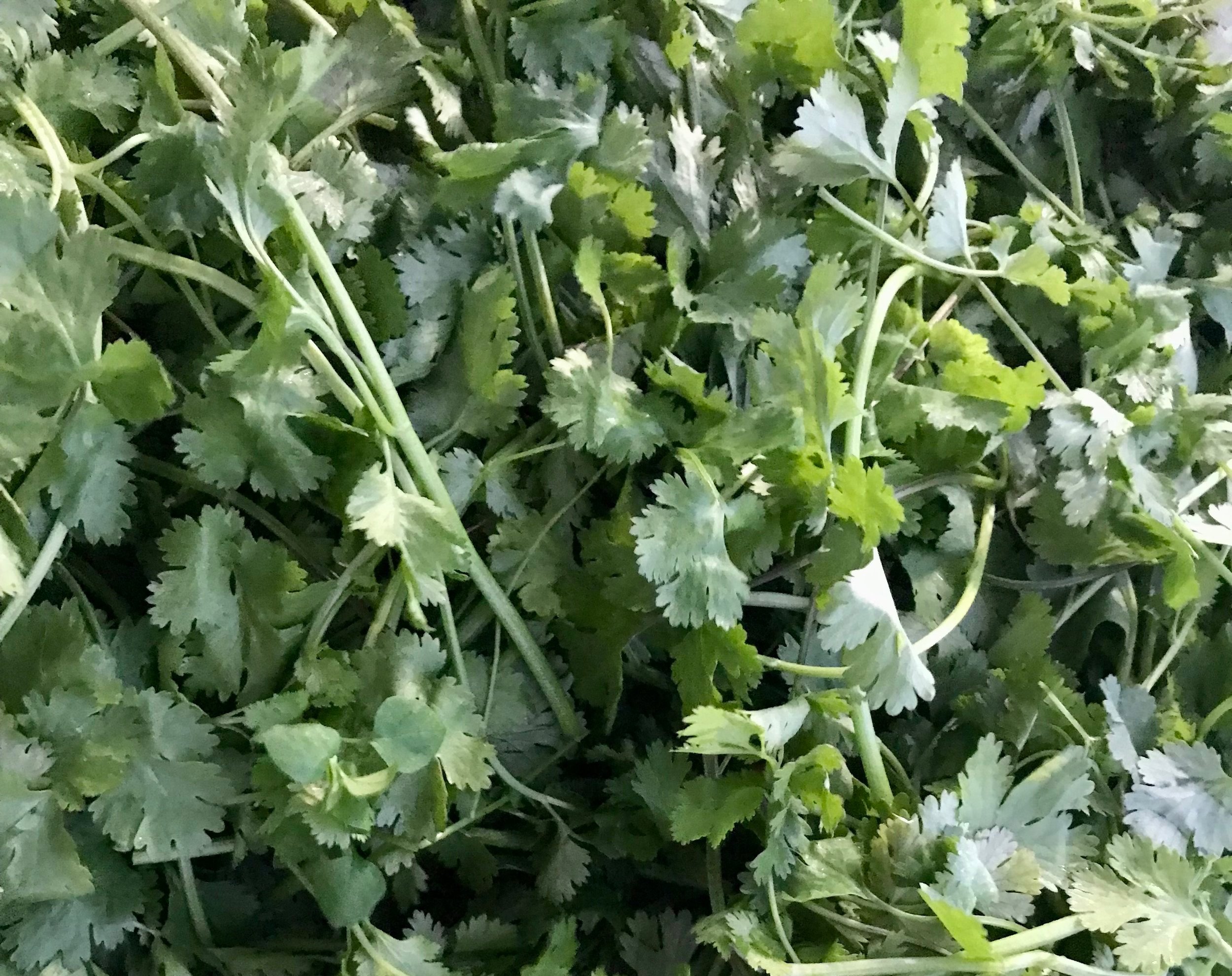Fresh off a weeding, North Garden Blocks 1-3 are looking good.
In a barn-office cleanup last week, Noah pulled a battered legal pad from the stacks. The top page was covered in cryptic notes: letters, numbers, columns, boxes with “seed” “growth” “harvest” “tarp,” arrows and X’d out attempts at making it all align. “What….is this?” he asked, laughing only harder when he saw the answer to the question, the top of the page clearly titled “Cilantro Theory.”
You might not think cilantro needs a unifying theory, but when we sit down in the winter to figure out how it all fits together, there are questions like “how many beds would we need in order to plant and harvest 30 feet of cilantro for a continuous weekly supply all summer and into the fall?” I confess to geeking out a little bit (ok, a lot) at a challenge like this and I did in fact spend one whole piece of paper diagraming the sections, the weeks of growth needed, the turnover time. The conclusion of the Grand Cilantro Theory was that in theory we could have three adjacent beds, each divided into four 30-foot sections. Each week one section would be seeded, one section would be harvested and tarped to let the worms digest it down for the next round in another 4 weeks, and the other sections would either be growing or being harvested. And, in theory this 12-foot by 120-foot cilantro plantation would keep you all evenly and perfectly supplied with the fragrant herb for the season.
A famous line on our farm is “And how’s that workin’ out for ya?” That was the response Noah got from his old friend Forest Pritchard, author of “Gaining Ground,” when Noah explained, while catching up at a friends’ wedding, that he wanted to scale back on the international consulting work and grow food for us and other people.
So, how’s that Cilantro Theory working out for us? That’s the thing with farming, and maybe with life. There’s theory, and then there’s practice. And then, as we’ll explain in a moment, there is cilantro pesto. Because Cilantro Theory got shaky early on in the game: the first succession, transplanted as soon as we could get into the field got, a bit weedy. OK, let’s be honest: last Friday the chickweed in that area was so thick that despite perfect sized crop, we brought no cilantro to market because the thought of harvesting it through the weed forest was so daunting. We did a big old weeding this week and boom, a lovely batch of cilantro for the farmstore! Three or four days later (today), Flora was harvesting in that section and noticed some stems starting to bolt….the theory was starting to fall apart again! We were nowhere near harvesting out that first section before it got too far gone. She jumped ahead to the next section, which yielded lovely bunches for market, but what to do with the remaining 20 feet of almost-perfect-but-on-the-cusp-of-bolting cilantro? It all needed to go immediately if not sooner. The answer, we decided, was pesto. Whenever the cilantro in our home garden threatened us like that, we cut it all quickly tried to use it up, and nothing absorbs a big batch of herbs quite as well as pesto.
So this week at market and the farmstore, you’ll find BIG bags of pesto-grade cilantro. Not perfect, but perfect for making a batch of super-flavorful pesto, sauce, or whatever you might like to do with cilantro in quantity. There are many recipes out there for cilantro pesto, but we generally wing it, blending the cilantro with some olive oil, lemon juice, salt, whatever nuts we have on hand, and maybe some hot peppers or chili flakes, until we reach a taste we like. Some recipes will tell you to separate the leaves from the stems, but we usually do it stems and all (Do we look like people who have time for de-stemming? If you do have that time, by all means go for it, your pesto will be smoother; if not, don’t sweat it.) It’s a great way this week to make something delicious out of a theory that went a little off the rails. And for the anti-cilantro crowd, don’t worry, there are many many other things coming to market in startling quantities as well.
We know enough from our fast-accumulating years of farming to know that theory and practice can end up looking very different, and not just when it comes to cilantro. We always have to be ready to adjust, to adapt to the reality that emerges on the ground. Theory: we can’t hire any crew with dogs because Malaya is a queen who will extract respect by force and could never tolerate another dog on the farm. Practice: Sabrina, the most qualified applicant when we desperately needed help on the farm, came with sidekick Willa, an exuberant herding-type dog of exactly the sort Malaya loves to hate. Pesto: a handful of dogfights, a few moths to learn each other’s vocabulary (Willa’s herding snaps aren’t real fighting-words, and yes Willa, Malaya will kick your stubby little butt if she sees you touch her stuff, so be stealthy about it at least), and we have a functional if ridiculously mis-matched pack of farm dogs, and a rockstar farmer on the team who in just a few short months will celebrate an unheard of milestone at SweetRoot, two whole years as a member of the team.
It’s a good week for a moment of Sabrina appreciation: she harvested a HUGE amount of this week’s market offerings single-handedly today while the rest of worked on bed prep and planting, and pulled off the majority of the work for those garden-start packages that people picked up last weekend. She also had a birthday this week, so if you see her zipping by with a loaded garden cart, or a tractor bucket full of goodies for the chickens, give a big happy birthday shout or, even better, a round of applause. As we continue to develop as a farm, to explore the theory of what infrastructure we need, how to build it and also keep our sanity, what size crew is right, etc.., and work out the practice of farming, we are incredibly grateful to have her as a part of the core team. From the determined quest for crack-free heirloom tomatoes to the ever-expanding unusual interests (anyone else out there ever taught yourself to play the hurdy-gurdy?) to the ability to grab three frightened quail in one handful to rescue them from the hoop-house, to the creative artworks many of your are currently wearing or carrying around on your feedbags, we are grateful for everything Sabrina has added to the farm.
Roots Theory is holding so far, and market will have beets and sweet, sweet little carrots. The above photograph is from our second planting; so if it looks a little small, don’t worry — we are harvesting out of one of our unheated high tunnels (our name for a greenhouse) now. An innovation to our moveable caterpillars this year is overhead sprinklers that run down the central steel perlin. These sprinklers are connected to a low-voltage controller that waters these roots a few times a day.
And what else will be at market tomorrow? It’s not just cilantro in the big bags…we also had a patch of second-cutting spinach that was too good to just flail mow, so we have big one-pound bags of that for cooking (saag panner, anyone?), plus kale and chard and mustard greens bunches, boc choi, carrots, beets, scallions, radishes, salad turnips, mint and parsley and head lettuces the size of your head, fresh pastured eggs…and more. Come on out and see us; the season is really getting started now, and the market trailer will be loaded.
With grattitude and big greens,
Mary and Noah, and all of SweetRoot Farm
Cover crop in the front corner gets a first mowing with the flail mower on our walk-behind tractor; these crops are feeding the soil to prepare for winter caterpillar tunnels full of greens.




